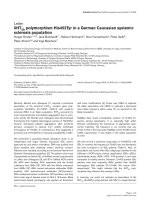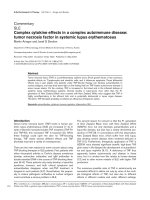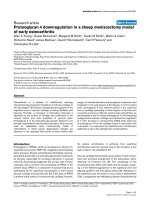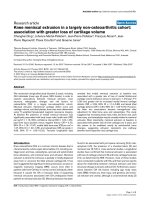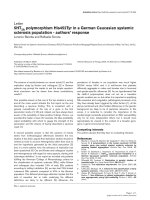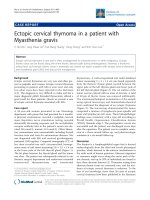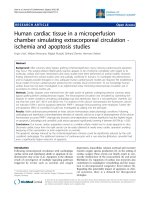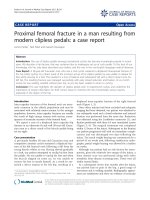Báo cáo y học: "Provider-initiated HIV testing in rural Haiti: low rate of missed opportunities for diagnosis of HIV in a primary care clinic" ppsx
Bạn đang xem bản rút gọn của tài liệu. Xem và tải ngay bản đầy đủ của tài liệu tại đây (212.33 KB, 5 trang )
BioMed Central
Page 1 of 5
(page number not for citation purposes)
AIDS Research and Therapy
Open Access
Short report
Provider-initiated HIV testing in rural Haiti: low rate of missed
opportunities for diagnosis of HIV in a primary care clinic
Louise C Ivers*
1,3
, Kenneth A Freedberg
2
and Joia S Mukherjee
1,3
Address:
1
Department of Medicine, Brigham and Women's Hospital, Harvard Medical School, Boston, USA,
2
Department of Medicine,
Massachusetts General Hospital, Harvard Medical School, Boston, USA and
3
Partners In Health, Boston, USA
Email: Louise C Ivers* - ; Kenneth A Freedberg - ; Joia S Mukherjee -
* Corresponding author
Abstract
As HIV treatment is scaled-up in resource-poor settings, the timely identification of persons with
HIV infection remains an important challenge. Most people with HIV are unaware of their status,
and those who are often present late in the course of their illness. Free-standing voluntary
counseling and testing sites often have poor uptake of testing. We aimed to evaluate a 'provider-
initiated' HIV testing strategy in a primary care clinic in rural resource-poor Haiti by reviewing the
number of visits made to clinic before an HIV test was performed in those who were ultimately
found to have HIV infection. In collaboration with the Haitian Ministry of Health, a non-
governmental organization (Partners In Health) scaled up HIV care in central Haiti by reinforcing
primary care clinics, instituting provider-initiated HIV testing and by providing HIV treatment in the
context of primary medical care, free of charge to patients. Among a cohort of people with HIV
infection, we assessed retrospectively for delays in or 'missed opportunities' for diagnosis of HIV
by the providers in one clinic. Of the first 117 patients diagnosed with HIV in one clinic, 100 (85%)
were diagnosed at the first medical encounter. Median delay in diagnosis for the remaining 17 was
only 62 days (IQR 19 – 122; range 1 – 272). There was no statistical difference in CD4 cell count
between those with and without a delay. 3787 HIV tests were performed in the period reviewed.
Provider-initiated testing was associated with high volume uptake of HIV testing and minimal delay
between first medical encounter and diagnosis of HIV infection. In scale up of HIV care, provider-
initiated HIV testing at primary care clinics can be a successful strategy to identify patients with HIV
infection.
Introduction
Only 5–8% of individuals with Human Immunodefi-
ciency Virus (HIV) infection globally are aware of their
diagnosis [1]. In the developing world, early 'in-program'
mortality has been prominent in a number of HIV treat-
ment programs, often due to patients presenting late for
care with already advanced disease [2]. In the ongoing
effort to prevent new HIV infections and to treat those
with established infection, emphasis must be placed on
developing strategies to effectively identify and engage
HIV-infected patients into care, with HIV testing as a crit-
ical step.
Much of the HIV testing in the developing world is done
through maternity clinics offering antiretroviral drugs for
the prevention of maternal to child transmission of HIV
or specialty voluntary counseling and testing (VCT) clinics
to which people come desiring knowledge of their status.
Published: 29 November 2007
AIDS Research and Therapy 2007, 4:28 doi:10.1186/1742-6405-4-28
Received: 19 January 2007
Accepted: 29 November 2007
This article is available from: />© 2007 Ivers et al; licensee BioMed Central Ltd.
This is an Open Access article distributed under the terms of the Creative Commons Attribution License ( />),
which permits unrestricted use, distribution, and reproduction in any medium, provided the original work is properly cited.
AIDS Research and Therapy 2007, 4:28 />Page 2 of 5
(page number not for citation purposes)
Studies from such settings in South Africa and Côte
d'Ivoire have identified factors including 'fear of a positive
HIV test', low levels of education and poor housing as
associated with low uptake rates [3,4]. US and African
studies have identified high rates of "missed opportuni-
ties" for making the diagnosis of HIV among primary care
clinicians who did not offer HIV tests to their patients
even if they had clinical syndromes associated with HIV
infection or if they were from a high-risk sociodemo-
graphic group [5-10].
In Haiti neither primary health care nor HIV VCT is widely
available and the estimated HIV prevalence is estimated
between 2.2 and 3.8% [11,12]. In the central plateau
department, a 2005 Demographic and Health Survey
reported the seroprevalence of HIV in 15–49 year olds as
1.6% [12]. In 2002, when the Global Fund to Fight AIDS,
TB and Malaria called for applications, Partners In Health
– a non-profit organization affiliated with Harvard Medi-
cal School – began a collaborative program with the Haiti
Ministry of Health with the goal of improving access to
primary care as an avenue to provide HIV prevention, test-
ing and treatment. To achieve this goal, staffing levels
were improved for general patient care and non-HIV
related essential medicines were provided free of charge to
patients seeking care. All health care providers – including
doctors, nurses, social workers and community health
workers were educated about the signs and symptoms of
HIV, the importance of active case finding and contact
tracing and the urgency for testing those who appeared ill
even if they did not present specifically for HIV testing. To
determine whether this approach was effective in identify-
ing patients with HIV in a timely manner, we reviewed the
number of clinic visits that a patient had prior to ulti-
mately testing HIV positive in one of our clinics.
Methods
We performed a retrospective chart review of 117 patients
who were ultimately diagnosed with HIV infection attend-
ing a public general medical clinic revitalized with monies
from the GFATM in Boucan Carré, Haiti, between March
1, 2003 and December 31, 2003. Medical records were
reviewed for each HIV-infected patient and the following
data were abstracted: age, sex, date of HIV diagnosis, date
of first visit to the clinic, number of encounters at the
clinic prior to HIV diagnosis, number of days between first
visit and diagnosis, and CD4 cell count at time of diagno-
sis. Any visit to the clinic before the diagnosis of HIV was
made (dating back to March 2003) was considered to be
a 'missed opportunity' for that patient. Prior to March
2003 the medical clinic was only minimally functional
and records were inconsistently kept, HIV testing and
treatment and most primary healthcare services were not
available (see discussion for further details). 'Delay' was
defined as the number of days between the date of the first
visit to the clinic and the date that the diagnosis of HIV
was ultimately made. HIV testing was performed on
plasma specimens using a standardized algorithm of two
rapid tests [Determine™ HIV1/HIV2, (Abbott Pharmaceu-
ticals); Capillus™ HIV1/HIV2 (Cambridge Diagnostics Ire-
land Ltd)] with discordant results settled by Western Blot.
Statistical analysis was performed using SAS 9.1™software.
We used the Wilcoxon Rank Sum Test to assess differences
in CD4 cell count at the time of diagnosis between those
with and without a delay in diagnosis, and chi-square
analysis for comparison of proportions. This study was
approved by Brigham and Women's Hospital Institu-
tional Review Board in USA, and by the Zanmi Lasante
Ethics Committee in Haiti.
Results
During the review period, 3787 HIV tests were performed
and 117 patients were newly diagnosed with HIV infec-
tion and included in this study (seroprevalence 3.1%).
Fifty-five percent of adult visits (N = 6859) resulted in an
HIV test being completed. Of 117 patients diagnosed with
HIV, data on prior clinical encounters were available for
112. Medical record review suggested that none of the
individuals had previously had an HIV test. Seventy per-
cent were female. Median first CD4 cell count was 351
cells/mm
3
(Interquartile range 212 – 624; range 49 – 1568
cells/mm
3
). Seven patients (7.0%; 95% Confidence Inter-
val 2.9 – 13.9%) had CD4 cell counts <100 cells/mm
3
at
diagnosis and twenty-one patients (21%; 95% CI 13.5 –
30.3%) had CD4 cell counts <200 cells/mm
3
at diagnosis.
CD4 cell count data were missing for twelve patients.
Ninety-five of the 112 patients (84.8%; 95% CI 76.8 –
90.9%) had their HIV diagnosis made at the time of their
first clinic visit. Of the 17 patients not diagnosed on the
first visit, 14 (12.5%; 95% CI 7.0 – 20.0%) were tested
and diagnosed on the second visit, two (1.8%; 95% CI 0.2
– 6.3%) on the third visit and one (0.9%; 95% CI < 0.1 –
4.9%)) on the fifth visit to the clinic.
Of the 17 who were not diagnosed on the first visit, 14
were female (82%); three were male (18%). The median
delay in diagnosis (i.e. the number of days between first
clinic visit and HIV diagnosis) was 62 days (IQR 19 – 122;
range 1 to 272 days). No patient's diagnosis was delayed
as a result of refusing an HIV test. There was no significant
difference in median CD4 cell count between those
patients who had any delay in diagnosis (447 cells/mm
3
)
and those without a delay (350 cells/mm
3
, p = 0.79, Wil-
coxon Rank Sum U Test). No CD4 cell count data were
missing in the group with a delay in diagnosis. There was
no significant difference in median age, proportion of
females or proportion of patients with CD4 cell count
<200 cells/mm
3
between the two groups, although power
AIDS Research and Therapy 2007, 4:28 />Page 3 of 5
(page number not for citation purposes)
to detect differences between these groups was low. Table
1 represents descriptive data on the two groups.
Discussion
Since 2002, funding has become increasingly available to
support HIV treatment in the developing world [13,14].
HIV testing is the critical entry point not only for engage-
ment into treatment and care but also for primary and sec-
ondary prevention efforts [15]. Despite the increasing
number of HIV treatment programs in resource-poor set-
tings however, uptake of testing is often low and many
patients are being diagnosed only when they are pro-
foundly immunosuppressed [16-18]. While few studies
have investigated "missed opportunities" and delays in
testing in resource poor settings, one Ugandan hospital
documented that only half of the inpatients with HIV-
related illnesses were offered HIV tests prior to discharge
[7] and a South African study documented low uptake of
VCT services [19]. Few studies discuss the impact of pro-
vider-initiated testing strategies in resource poor settings.
In provider-initiated testing, the care provider recom-
mends and offers an HIV test to those individuals who are
considered to be at risk of infection. The counseling ses-
sion is primarily informational and educational, and
post-test counseling is provided based on the individuals
test result. By building on existing relationships in the
health care setting and on health care providers' experi-
ence and training, and by offering testing in the context of
comprehensive clinical care, provider-initiated testing
offers a unique opportunity to increase access to and
acceptance of HIV testing.
We evaluated a rural, developing country HIV scale-up
program with a provider-initiated strategy for HIV testing,
to determine if there were systematic delays in HIV diag-
nosis because clinicians missed opportunities for HIV test-
ing at the time of clinical encounters. We found that
ninety-seven percent of the patients with HIV were diag-
nosed by the time of their second visit to the clinic. For
those whose diagnosis was delayed, a median of only two
months passed between their first visit to the newly man-
aged clinic and their HIV diagnosis.
In our setting, pretest counseling is provided by the doctor
or nurse seeing the patient in the context of a full medical
consultation and other laboratory or radiologic tests as
required. Clients wait at the laboratory for their blood
sample to be processed and return to the same provider to
receive results. Positive HIV test results are hand-carried
by laboratory technicians to providers to ensure no loss to
follow up. The provider then initiates post-test coun-
seling, and in the event of a positive HIV test, enrolls the
patient into clinical care the same day, introducing them
to the HIV program social worker and nurse who continue
the formal post-test counseling process.
Boucan Carré is a rural, isolated region of Central Haiti,
with a population of 40,000 individuals, mostly subsist-
ence farmers, with approximately 23% of the population
between the ages of 15 and 49 years. The Partners In
Health/Ministry of Health clinic is the only formal health-
care center in the area and at the time of the study was
staffed with two physicians, a midwife, a pharmacist, two
laboratory technicians and three nurses. Refurbishment
activities by PIH began in March 2003 at this center, with
full scale up of HIV testing and treatment services availa-
ble by May of 2003. Prior to this time, the clinic was
staffed by one nurse, had frequent stock-outs, no inpa-
tient facilities, no antiretroviral therapy program and HIV
testing could only be performed by referral to a center in
either the capital city of Port-au-Prince or in the regional
capital of Hinche – both three hours away by car. We did
not review patients clinic visits prior to refurbishment and
support of the clinic in March 2003 because care was
extremely limited at that time, records were inconsistent,
and because our objective was not to demonstrate missed
opportunities for care in the context of a dysfunctional
public health clinic (where most opportunities for provid-
ing healthcare in the community are likely missed), but to
evaluate if there were missed opportunities in the context
of a minimal package of services during HIV scale up.
During the time period of review, there were no fixed, spe-
cific criteria in place for when to offer HIV testing, how-
ever, providers were encouraged to widely offer HIV
Table 1: Characteristics of 112 patients diagnosed with HIV infection in a public clinic in rural Haiti*
Diagnosis Delayed N
(%; 95%CI or IQR)
Diagnosis made at first visit N
(%; 95%CI or IQR)
p value
Patients (total N = 112) 17 95 -
Median age 28 32 0.44
Female 14 (82.3%; 56.6 – 96.2%) 60 (67.4%; 56.7 – 77.0%) 0.26
Median CD4 count (cells/mm3) 447(250 – 998) 350 (304 – 426) 0.79
CD4 < 200/mm3 2 (11.8%; 1.5 – 36.4%) 19 (22.9%; 14.3 – 33.4%) 0.35
Median no. of days delayed (range) 62 (19–122) N/A N/A
*There were no significant differences in these characteristics, although the study was not powered specifically to detect these differences (see
methods)
AIDS Research and Therapy 2007, 4:28 />Page 4 of 5
(page number not for citation purposes)
testing and were trained to identify clinical signs or symp-
toms of HIV-related disease and opportunistic infections
but not to limit testing to only those with suspicion of
immunosuppression. None of the patient charts of those
who were HIV-infected specifically suggested that the
patient had requested the HIV test (as opposed to being
initiated by the provider), but it may not be unusual for
clients who are interested in HIV testing to present to pri-
mary care clinic and to initially ask to be evaluated for
minor complaints. Our staff is also trained to identify this
possibility and, as mentioned above, to remain open to
offering HIV testing broadly.
The results of our study demonstrate that it is possible to
have a very low rate of missed opportunities for HIV test-
ing in a high-volume, rural, resource-poor clinic when
HIV counseling and testing is integrated into general med-
ical care. This very low rate of missed opportunities
occurs, we believe, as a result of a high level of staff aware-
ness and education regarding the importance of consider-
ing a diagnosis of HIV infection, and because the same
clinician who sees the patient for medical care provides
the counseling for HIV testing. This means that HIV vol-
untary counseling and testing is incorporated into medi-
cal care, with no separate wait or visit required by the
patient. HIV test results are available within 15 minutes.
Comprehensive HIV treatment is available at the clinic.
This study has a number of limitations. It is a retrospec-
tive, observational study of patients known to have HIV
infection and it does not provide information regarding
the HIV status of patients who were not offered testing by
the staff. Since the exact number of missed diagnoses of
HIV is not known, it is possible that a number of those not
tested actually did have HIV. However 55% of patient vis-
its resulted in an HIV test and it is likely that in fact more
than 55% of patients were tested, since repeat patient vis-
its often occur in the outpatient department but repeat
HIV testing within a period of 9 months is rare. Over a 3-
year period, 15,000 HIV tests have been performed at the
Boucan Carré health center and the HIV prevalence
among those tested of 3% has remained consistent with
the prevalence reported in this study – almost double the
reported local prevalence. This suggests that only a very
small proportion of the untested patients could be
infected. Furthermore, those found to have HIV in the
clinic had higher CD4 counts at diagnosis than those of
individuals diagnosed with HIV in the US or Africa [6,20].
Even if in fact many cases of HIV were missed in Boucan
Carre, it is likely that their CD4 counts would have been
even higher, since patients who did not have HIV testing
would have been less likely to be symptomatic.
Finally, the power to detect clinically meaningful differ-
ences between the two groups was low and the lack of dif-
ferences in Table 1 should not be over-interpreted.
In summary, in contrast to similar studies in US and
Africa, we found a very low rate of missed opportunities
for HIV testing in a rural, resource-limited clinic setting in
Haiti after staff was trained and primary care services were
reinforced. This demonstrates the success of a rural HIV
testing program that is integrated into primary medical
care and initiated by providers. HIV prevention and treat-
ment programs will not achieve success without address-
ing the urgent need for individuals to be aware of their
HIV status in a timely manner and provider-initiated test-
ing can be a successful strategy to address this concern.
The authors wish to thank Partners In Health/Zanmi Las-
ante staff and patients. This work was supported in part by
the National Institute of Allergy and Infectious Disease
(T32AI07433, K24AI062476, K23AI063998) and through
Partners In Health, the Global Fund to Fight AIDS, Tuber-
culosis, and Malaria, the Haitian Ministry of Health and
numerous private donors. Thanks to Martin Hirsch, MD
and Garrett Fitzmaurice, PhD for helpful comments on
the manuscript.
Competing interests
The author(s) declare that they have no competing inter-
ests.
Authors' contributions
LCI designed the study, collected the data and drafted the
manuscript. JSM and KAF contributed to the design of the
study and helped to draft the manuscript. All authors read
and approve the final manuscript.
Acknowledgements
Preliminary data from this study were presented at the 42
nd
Annual Meeting
of the Infectious Diseases Society of America, Sept 30–Oct 3, 2004, Boston,
USA. Abstract 835.
References
1. Mukherjee JS, Farmer PE, Niyizonkiza D, McCorkle L, Vanderwarker
C, Teixeira P, Kim JY: Tackling HIV in resource poor countries.
BMJ 2003, 327(7423):1104-1106.
2. Dabis F, Schechter M, Egger M, Groups ARTLINCARTCCS:
Response to highly active retroviral therapy in low- and high-
income countries: analysis from 4 continents. Abstract 73.
Feb 22-25: Boston, MA, USA. ; 2005.
3. Ginwalla SK, Grant AD, Day JH, Dlova TW, Macintyre S, Baggaley R,
Churchyard GJ: Use of UNAIDS tools to evaluate HIV volun-
tary counselling and testing services for mineworkers in
South Africa. AIDS Care 2002, 14(5):707-726.
4. Msellati P, Juillet-Amari A, Prudhomme J, Akribi HA, Coulibaly-Traore
D, Souville M, Moatti JP, Cote d'Ivoire HIVDAISBEG: Socio-eco-
nomic and health characteristics of HIV-infected patients
seeking care in relation to access to the Drug Access Initia-
tive and to antiretroviral treatment in Cote d'Ivoire. AIDS
2003, 17 Suppl 3:S63-8.
5. Undersecretary for Health's Information Letter. Need for
routine Human Immunodeficiency Virus (HIV) risk assess-
Publish with BioMed Central and every
scientist can read your work free of charge
"BioMed Central will be the most significant development for
disseminating the results of biomedical research in our lifetime."
Sir Paul Nurse, Cancer Research UK
Your research papers will be:
available free of charge to the entire biomedical community
peer reviewed and published immediately upon acceptance
cited in PubMed and archived on PubMed Central
yours — you keep the copyright
Submit your manuscript here:
/>BioMedcentral
AIDS Research and Therapy 2007, 4:28 />Page 5 of 5
(page number not for citation purposes)
ment and testing. Sept 2 2005 2005 [http://
www.vethealth.cio.med.va.gov/Pubs/10200517.pdf]. Accessed Jan 20
2006
6. Liddicoat RV, Horton NJ, Urban R, Maier E, Christiansen D, Samet JH:
Assessing Missed Opportunities for HIV Testing in Medical
Settings. J Gen Intern Med 2004, 19(4):349-356.
7. Wanyenze R, Kamya M, Liechty CA, Ronald A, Guzman DJ, Wabwire-
Mangen F, Mayanja-Kizza H, Bangsberg DR: HIV counseling and
testing practices at an urban hospital in Kampala, Uganda.
AIDS Behav 2006, 10(4):361-367.
8. MacDonald SR, Skor A, Socol ML, Garcia PM: Human immunode-
ficiency virus infection and women: a survey of missed
opportunities for testing and diagnosis. Am J Obstet Gynecol
1998, 178(6):1264-1271.
9. Jenkins TC, Gardner EM, Thrun MW, Cohn DL, Burman WJ: Risk-
based human immunodeficiency virus (HIV) testing fails to
detect the majority of HIV-infected persons in medical care
Settings. Sexually Transmitted Diseases 2006, 33(5):329-333.
10. Kuo AM, Haukoos JS, Witt MD, Babaie ML, Lewis RJ: Recognition
of undiagnosed HIV infection: an evaluation of missed oppor-
tunities in a predominantly urban minority population. AIDS
Patient Care & Stds 2005, 19(4):239-246.
11. UNAIDS: 2004 Report on the Global AIDS Epidemic. Geneva
, UNAIDS; 2004.
12. MEASURE DHS. Haiti 2005-2006 Survey on Mortality, Mor-
bidity and Utilization of Services. 2007 [s ure-
dhs.com].
13. Uttayamakul S, Likanonsakul S, Sunthornkachit R, Kuntiranont K, Lou-
isirirotchanakul S, Chaovavanich A, Thiamchai V, Tanprasertsuk S,
Sutthent R: Usage of dried blood spots for molecular diagnosis
and monitoring HIV-1 infection. Journal of Virological Methods
2005, 128(1-2):128-134.
14. Attaran A, Sachs J: Defining and refining international donor
support for combating the AIDS pandemic. Lancet 2001,
357:57-61.
15. Chou R, Huffman LH, Fu R, Smits AK, Korthuis PT: Screening for
HIV: A Review of the Evidence for the U.S. Preventive Serv-
ices Task Force. Ann Intern Med 2005, 143(1):55-73.
16. Coetzee D, Hildebrand K, Boulle A, Maartens G, Louis F, Labatala V,
Reuter H, Ntwana N, Goemaere E: Outcomes after two years of
providing antiretroviral treatment in Khayelitsha, South
Africa. AIDS 2004, 18(6):887-895.
17. Orrell C, Bangsberg DR, Badri M, Wood R: Adherence is not a
barrier to successful antiretroviral therapy in South Africa.
AIDS 2003, 17(9):1369-1375.
18. Tassie JM, Szumilin E, Calmy A, Goemaere E: Highly active antiret-
roviral therapy in resource-poor settings: the experience of
Medecins Sans Frontieres. AIDS 2003, 17(13):1995-1997.
19. Hutchinson PL, Mahlalela X: Utilization of voluntary counseling
and testing services in the Eastern Cape, South Africa. AIDS
Care 2006, 18(5):446-455.
20. van der Loeff MF, Awasana AA, Sarge-Njie R, van der Sande M, Jaye
A, Sabally S, Corrah T, McConkey SJ, Whittle HC: Sixteen years of
HIV surveillance in a West African research clinic reveals
divergent epidemic trends of HIV-1 and HIV-2.[see com-
ment]. International Journal of Epidemiology 2006, 35(5):1322-1328.

